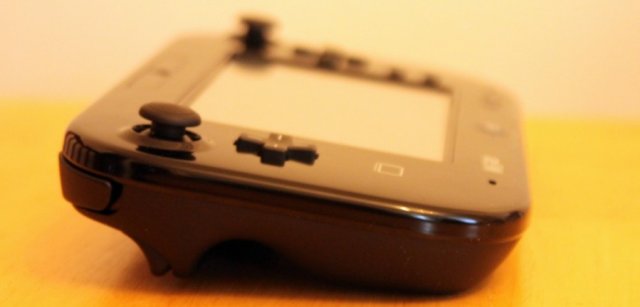
Will U
Unfortunately, I can’t tell you any of that. As of mid-day Saturday, mere hours from the system's North American launch, Nintendo had not yet pushed out a promised firmware update to activate all of these features (and maybe a few that I’m not aware of). (Note: Nintendo did push the firmware update at about 6pm CT, five hours before the company's embargo on reviews of the hardware was set to lift. We'll have reporting on the extra features as soon as we've tested them.)
There are a lot of things I’d love to tell you about the Wii U. I’d love to tell you how the Miiverse social networking service lets you play games and exchange messages with friends. I’d love to tell you how the GamePad’s built-in camera works for video chatting with other Wii U owners all over the world. I’d love to tell you about the transfer process for content from your old Wii, or how the new system handles old Wii retail games, or how easy it is to expand the storage space with a USB hard drive, or what the sign-up process for the new Nintendo Network ID is like, or how functional the Web browser and free video apps are, or how the new eShop compares to other digital download services.
Unfortunately, I can’t tell you any of that. As of mid-day Saturday, mere hours from the system's North American launch, Nintendo had not yet pushed out a promised firmware update to activate all of these features (and maybe a few that I’m not aware of). (Note: Nintendo did push the firmware update at about 6pm CT, five hours before the company's embargo on reviews of the hardware was set to lift. We'll have reporting on the extra features as soon as we've tested them.)
As a result, this first review of the Wii U is going to be necessarily incomplete. While I can offer an extensive review on the Wii U hardware and the unique new touchscreen GamePad controller (Ars reviewed some of the system's big launch games earlier this week as well), I can't yet offer an opinion on many of the system's promised features.
Of course, we'll be sure to update our thoughts as these features are introduced post-launch. But until then, a large portion of the Wii U is best exemplified by the screen that greets me when I turn on the system: my Mii standing all alone in a vast expanse of nothingness, waiting for stuff to do.
The Hardware

If you can tell the difference between this Wii U screenshot and another version of Mass Effect 3, you have a better eye than I do.
One of the biggest questions dogging the Wii U in the run-up to its release was how its processing power compares to that of other current-generation consoles. Unfortunately, the verdict on that is still largely out.
One thing is clear, at least—the HD graphics on the Wii U are at least on par with those of current HD systems. I loaded up the opening cut scene for Mass Effect 3 simultaneously on both my Xbox 360 and the Wii U, switching TV inputs to compare the rendering between them. If there was any difference in the quality, I couldn’t make it out.
But if the Wii U is capable of generating graphics more detailed than those of other current systems, the launch games I’ve seen so far don’t do a great job showing that off. First-party titles like New Super Mario Bros. U and Nintendo Land capture the company’s signature bright, cartoony style, but they come across as high-definition versions of games that would have been possible on the original Wii. Third-party titles like ZombiU and Tank Tank Tank! show more detail and have more moving elements than what was possible on the original Wii, but those titles are far from out-classing complex games on the Xbox 360 or PlayStation 3. Most of the other launch titles are direct ports of games actually available on those systems. These look indistinguishable on the Wii U.
I’m willing to believe the Wii U is more powerful than the older HD consoles though, primarily because the system is also pushing a lag-free wireless image to the Wii U GamePad while it generates those HDTV graphics. Sometimes that touchscreen image is just a mirror of what’s happening on the TV, but often it’s a totally different viewpoint of the same scene, or a different scene entirely. I’d have to imagine ignoring the touchscreen altogether might actually give developers more horsepower to spend on the image being pushed to the TV.
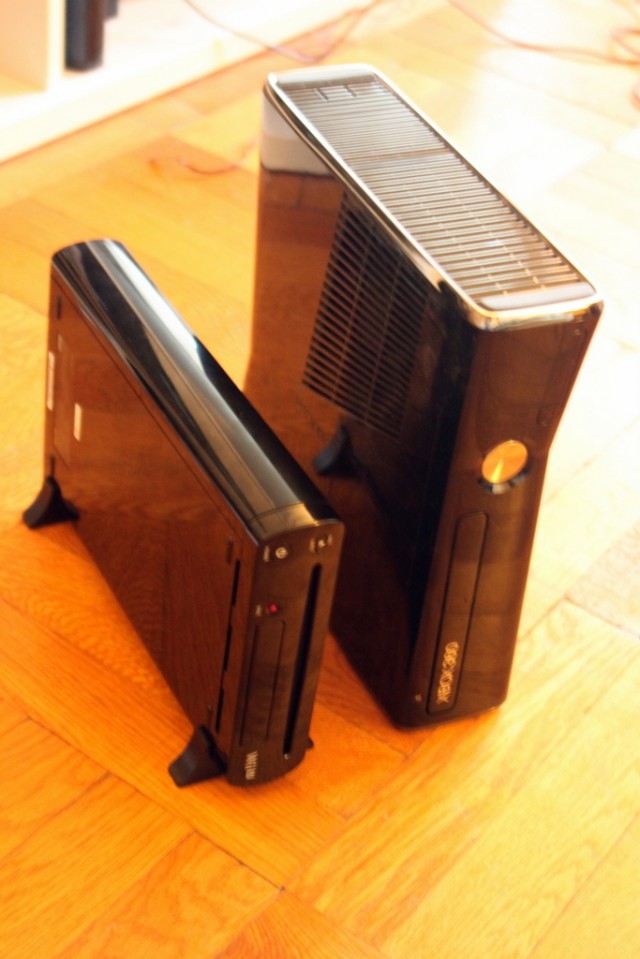
The Wii U and the Xbox 360 Slim (the Wii U is the small one\0
We covered our first impressions of the physical hardware when we first got our hands on the system, but it’s worth noting again how small the Wii U is compared to even the reduced-size revisions of other HD consoles. At 1.8" high and 6.8" wide, the unit is barely bigger than the minuscule Wii when viewed from the front and is only noticeably larger when extending to the 10.5" depth. If you already have a Wii in your entertainment center, the Wii U should fit in as a fine replacement with no problem.
Nintendo has added a lot of nice small touches to the system, too. The power and eject buttons rest flush with the front of the system, making for a nice, smooth surface that is quite pleasing to look at. The cover that conceals the front USB ports and SD card slot retracts into the system, rather than protruding out when opened, to preserve those flush lines.
There’s also a small LED light to indicate when there’s a disc in the system, a head-smackingly obvious addition I hope other system makers will copy from here on out. My only real complaint with the physical hardware is that the shiny finish on my black, Deluxe system is a magnet for thumbprints. It's quite easy to smudge any time you move the system around.
Load Times
One of my first thoughts when playing the Wii U was that the games appeared to take a long time to load. Games like Just Dance 4, Madden NFL 13, and Ninja Gaiden seem to take forever to load even basic menus and scenes. But when I actually broke out a watch and compared the Wii U’s load times to launch window games for other recent systems, I found the delay was generally within historical norms.
You can see the results of my testing in the table below. The first column is the number of seconds from first loading the game to seeing the first warning message or company logo displayed by the game itself. The second number shows the total time it takes to get from the Wii U menu to the first interactive in-game menu (after skipping all skippable logos and intros). The third number is the amount of time it takes from choosing "new game" or "continue game" on the first menu to getting actual controllable gameplay. I’ll let the numbers speak for themselves.
| GAME | TIME TO LOGO | TIME TO MENU | TIME TO LOAD GAMEPLAY |
|---|---|---|---|
| Nintendo Land | N/A | 25 | 12 |
| New SMB U | 21 | 27 | 7 |
| ZombiU | 14 | 35 | 54 |
| Just Dance 4 | 17 | 90 | 14 |
| Batman: Arkham City | 19 | 39 | 12 |
| Ninja Gaiden 3 | 17 | 41 | 60 |
| Mass Effect 3 | 18 | 50 | 34 |
| Sing Party | 18 | 32 | 12 |
| Epic Mickey 2 | 35 | 44 | 8 |
| Madden NFL 13 | 19 | 60 | 54 |
| Wii U average | 19.8 | 44.3 | 26.7 |
| Oblivion (Xbox 360) | 14 | 38 | 21 |
| Heavenly Sword (PS3) | 9 | 58 | 49 |
| Zelda: Twilight Princess (Wii) | 14 | 17 | 5 |
The GamePad

This shot shows how the ridge helps support the system during normal play, and how awkward the shoulder button placement is.
The wireless Wii U GamePad is by far the most interesting thing about the system. It's an odd combination of standard buttons and analog sticks, with a 6.2", 854×480 resolution touchscreen. It's something we've never really seen before in the gaming world. While the new controller is unlikely to cause the stir that the original Wii Remote did, it's still a well-made product that brings a lot to the table.
Ergonomics
While I had some experience holding the Wii U GamePad during pre-release press events, I was concerned that the heavy, 1.1 pound (500 gram) controller would feel cumbersome after multi-hour play sessions. But the added weight over a standard, touchscreen-free controller was barely noticeable (even after handling the unit for five hours at a time).
The key to the comfort is the rounded ridge on the backside of the controller. As you hold the system with your thumbs naturally resting on the analog sticks or buttons, your middle fingers naturally tuck in under this ridge, spreading the weight of the controller out a little bit. Below the ridge are a couple of vertical bumps that let your other fingers wrap gently around the back, preventing the kind of death grip you need to fully support some heavier tablets or smaller portable systems.
Things are a little less comfortable when you’re forced to hold the tablet in one hand and tap away with the stylus in the other. The ridge still helps here, and the controller’s size and shape make it easier to hold in one hand than the Nintendo DS line. But held with one hand, the GamePad's center of gravity pushes the controller uncomfortably into your palm. Here, the added weight is a bit more noticeable (especially if you’re a weakling like me). In these situations, I found myself often resting the controller on my lap as I propped it up with one hand, rather than holding it up completely in front of me.
The biggest ergonomic problem with the GamePad comes in the shoulder buttons. Two of these buttons, ZL and ZR, rest on top of the back ridge and provide a perfectly natural resting place for your index fingers. The others, labeled L and R, sit on the top edge of the GamePad, roughly an inch higher. With your middle fingers under the ridge, reaching up to hit these shoulder buttons with your index finger is an uncomfortable stretch.
Moving your index fingers quickly between the two sets of shoulder buttons is also quite a bit more awkward than doing the same on the Xbox 360 or PS3 (where the buttons are at the same vertical height). It’s possible to put your ring finger under the ridge and rest both your middle and index fingers on the shoulder buttons, but this setup felt a bit unnatural to me.
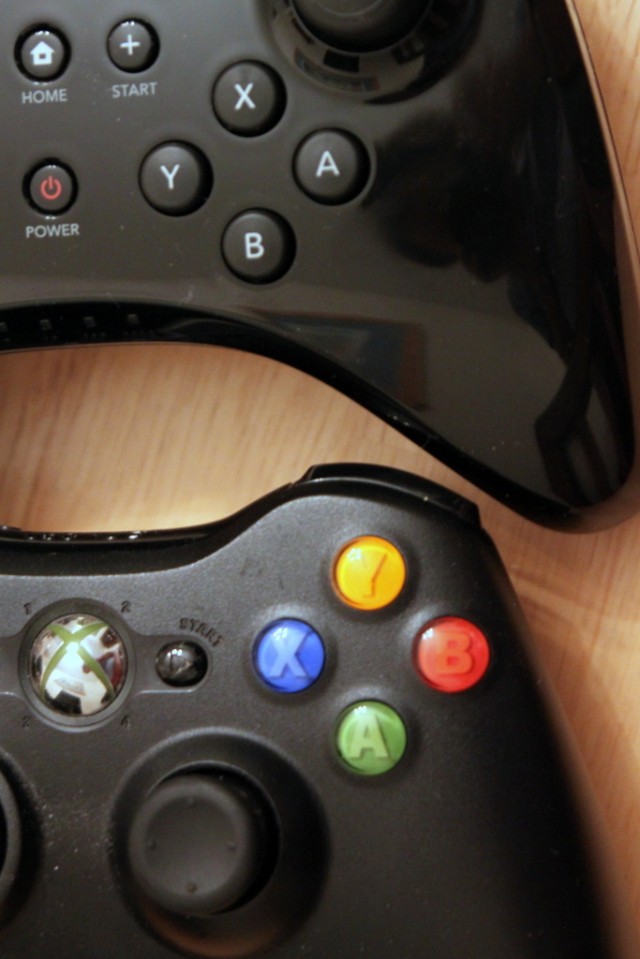
You just had to flip the placement of the buttons and the analog stick, didn't you Nintendo?
I’m also a bit confused by Nintendo’s decision to place the GamePad's right analog stick above the four face buttons on the controller. Years of play on the PlayStation and Xbox lines and even the GameCube have trained me to expect that face buttons will be above and to the right of the right analog stick. My brain did a bit of a double take every time I had to move down and left to go from stick to buttons on the Wii U GamePad. It doesn’t feel uncomfortable per se—everything is in an ergonomically fine position—but it's something I’ll have to get used to when playing on the system (the Wii U Pro Controller has the same problem).
The two analog sticks on the Wii U GamePad are almost exactly the same size as those on a Wii Nunchuk, and they spring back to center with the same amount of force. While the Nunchuk featured eight notches around the edge to help you find cardinal and intercardinal directions easily, the Wii U went with the kind of rounded edges that other major controllers sport. This was a disappointing change. Unlike the Xbox 360 analog sticks, which have a small divot to rest your thumbs, the Wii U analog sticks are completely convex. This makes it a tad harder to gain a grip on the rubbery surface. That said, there is a very slight lip to give your thumb some idea of where it is in relation to the edge of the pad.
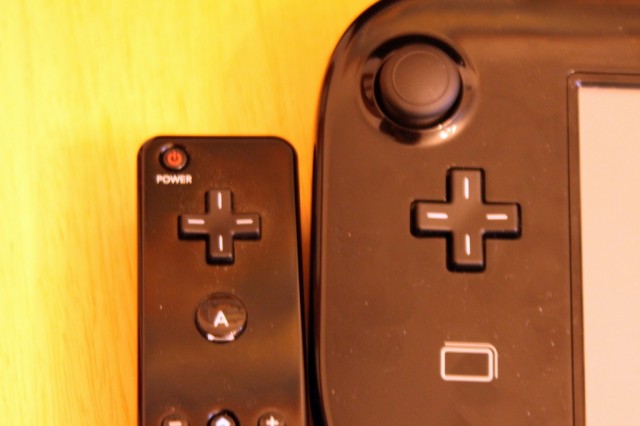
Now that's a macho, adult-sized directional pad! On the right, I mean. *flex*
The GamePad’s digital directional pad is a great improvement over the dinkier one found on Wii Remotes, increasing the size to roughly that of the standard Super NES GamePad. The expanded size feels much more comfortable for adult hands without the weird rounded diagonals of the Xbox 360 pad or the empty space of the PS3 d-pad. The face buttons on the opposite side of the screen are pretty standard, and they offer resistance similar to that of other modern controller buttons.
Build Quality
Overall, the GamePad feels pretty durable. I haven’t tried dropping it from the roof of my apartment building or anything, but I haven’t exactly been gentle with it either, and it hasn’t developed a single scratch yet. The touchscreen surface itself feels a little plasticky, and there’s the tiniest bit of give when you press the stylus down with full force. But it's not enough to cause the kind of LCD rainbow effect you remember from your graphing calculator. The touchscreen is an incredibly smooth surface for sliding a finger across, though, and it doesn’t seem to attract fingerprint smudges like my iPad’s touchscreen does.
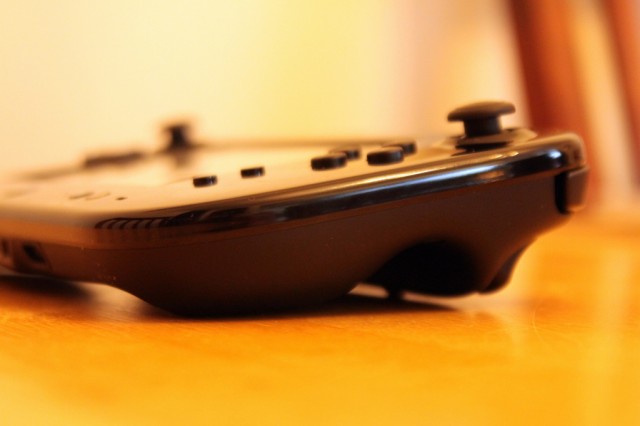
A close-up of the seam where the two distinct pieces of the GamePad shell come together.
The GamePad itself is contained within a shell that has two distinct plastic pieces, a rear piece with a matte finish that provides a bit more grip and a front piece with a gloss that’s so shiny you can see your reflection in it. The front piece snaps over and around the back piece, creating a nice, smooth, unified shell. Aesthetically, it looks a bit like a Playskool toy, but physically it feels more substantial than that. This thing isn’t going to snap apart even under significant strain. It seems like it could take a whack to a sibling’s face without being worse for the wear.
Even though the 6.2-inch, 854×480 display can’t replicate the high-definition images displayed on the TV screen (or even the kind of images you’d see on a retina display iOS device), I found the Wii U's screen sharp enough for most gameplay purposes. The sheer size of the screen is a revelation compared to standard portable game systems, outclassing even the 5" Vita screen in both width and height. Having such a large image right in your face is in some ways preferable to looking at the TV screen at the other end of the room. I found myself looking down rather than up instinctively when playing games shown on both screens.

In New Super Mario Bros. U, there's next to no lag between the TV scene and the identical GamePad scene. The image quality on the smaller screen is no slouch either.
The display is suitably bright at its highest setting, and while there’s significant glare in direct light, it’s really only an issue if there’s a lamp directly behind you. You can adjust the brightness through a buried touchscreen menu, but the lowest couple of brightness settings make things tough to see even under low ambient lighting conditions. I found using the second lowest setting barely tolerable, though using it did extend the functional battery life to just over four hours of active gameplay.
Ah yes, the battery life. If the GamePad has an Achilles heel, this is it. Nintendo’s advertised range of three to five hours is pretty accurate, with the screen brightness being the biggest factor in determining how long it will last in that range. The GamePad takes a little over two hours to charge completely after being drained.
In practice, this wasn’t too much of a hassle as long as I remembered to slide the GamePad into the convenient charging cradle included with the Deluxe system when I wasn’t using it. For marathon game sessions, you can plug the controller into an AC adapter and continue playing while it charges. This can be a problem if there isn’t a convenient wall outlet by your couch (though the included eight-foot long adapter cord mitigates this issue). The position of the charging port on the top edge of the GamePad keeps the cord out of the way for the most part, but it can get a little annoying if you need to tilt the system or hold it vertically for some games.

The charging cable and headphones stick out of the top of the GamePad rather unobtrusively.
Functionality
The GamePad's tilt sensitivity precision is probably its most surprising feature. This is best put to use in conjunction with the built-in screen to give you direct control of a first-person camera. Moving the GamePad around and seeing the image on the screen change perspective instantly (and accurately) is like looking through a portal to another world, creating a seamless bit of augmented reality that just isn’t possible on other systems. While the centering can get a little confused if you shake the GamePad violently to one side or the other, for the most part the effect was nothing short of magical.
The GamePad is a little less convenient for games that just require tilting the controller without using the screen. There were a few times I found myself wishing I was just holding a Wii Remote rather than struggling to lean the bigger and heavier GamePad quickly one way or the other. You’re not going to be swinging the GamePad like a Tennis racket, that’s for sure.
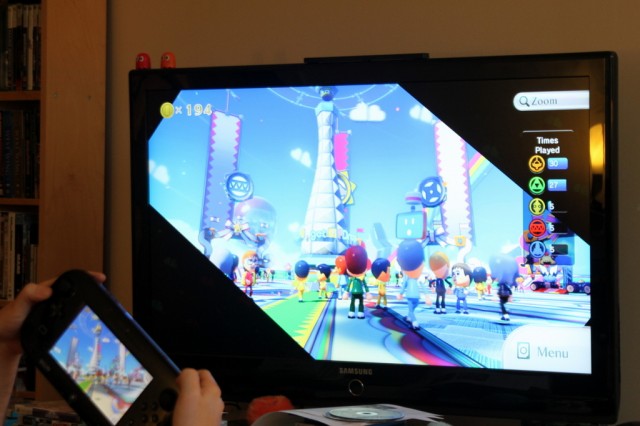
Twisting the GamePad and seeing the TV camera immediately twist the same way is kind of awesome.
For games that do support the Wii Remote, though, I found myself missing the added buttons and analog sticks provided by the Wii U GamePad. The optional, touchscreen-free Wii U Pro Controller is a decent compromise, but it doesn't have the motion sensing features of the GamePad or the Wii Remotes. It seems like there's a give and take in every control option.
Range is an important consideration with any wireless controller, but I didn’t have any trouble using the GamePad anywhere in my living room, where I could get as far as ten feet away from the system itself. At about 15 feet, the signal starts to deteriorate a little, and the touchscreen image started to show some pretty bad stuttering. Anymore than that and the GamePad simply displays a message that it can’t connect to the system. These ranges were pretty consistent regardless of whether there were any walls in the way, meaning I was able to play New Super Mario Bros. U in the kitchen, the bathroom, and part of the bedroom in my (somewhat cramped) apartment.
The GamePad's built-in speakers were also surprisingly good. Of course, it’s going to sound a lot tinnier than your TV’s sound system, but the sound fidelity and quality is a hell of a lot better than the crackling Wii Remote speakers. There’s even a functional surround sound mode—when I got fireworks at the end of a level in New Super Mario Bros. U, I could distinctly hear the explosions coming not just from the right and left side of the GamePad, but also the top and the bottom. A volume slider on the top ridge of the system makes adjustments convenient, and the headphone output seems decently powerful.

Oh yeah, the GamePad is also a bulky, limited TV remote control.
You can also use the Wii U GamePad as an IR remote for your TV. Setting this feature up went incredibly smoothly; I just told the system I had a Samsung TV the first time I turned it on and it worked perfectly (things might be a little more complicated for users with a cable box). Tapping the TV Control button right at the bottom of the GamePad at any time brings up a touchscreen menu letting you adjust volume, change channels, switch inputs, or even turn the TV power off and on.
This was convenient a few times during testing when I couldn’t find the TV remote or didn’t want to interrupt my play session to hunt it down. Still, it’s missing some features—an "info" button to tell me what show is currently playing or a "menu" button to adjust TV settings. Overall, it’s a nice extra feature, but not really a necessary one just yet.
Miscellaneous
- The Mii Channel on the Wii U is almost exactly like the one on the Wii, with the added ability to make Miis based on photos (as you can on the 3DS and DSi). You can import Miis from those portable systems quite easily, but there doesn't seem to be an option to actually transfer Miis held on Wii Remote yet.
- The Wii U can automatically detect your TV resolution and aspect ratio when connected through HDMI. It's a nice little touch.
- The rumble function on both the GamePad and the Wii U Pro Controller feels a little weak compared to those on other standard controllers, including the Wii Remote. I don’t know if this is a battery saving move or what, but it’s definitely noticeable.
- The Wii U automatically powers down after being left inactive for an hour. Even though you can turn this feature off, having it on by default is definitely a good move for the planet. Games likeNew Super Mario Bros. U even warn you may lose your unsaved data if you leave the system alone too long.
- You can turn off the GamePad screen when you’re not using it, but the screen automatically turns back on as soon as you touch a button on the GamePad. That makes the feature next to useless when playing games on the TV screen exclusively.
- There’s a distinct rattling when you shake the Wii U GamePad, as you’re required to in games likeNintendo Land. It seems like this noise comes from the face buttons, which are a little loose in their housing.
The Good
- Svelte hardware design is much smaller than competing systems
- HD graphics are easily the equal of the Xbox 360 and PS3
- GamePad is comfortable, sturdily built, and not too heavy
- Large touchscreen looks better than its low resolution would suggest
- Precise tilt-sensing turns the GamePad into an augmented reality portal
- GamePad's surround sound speakers are surprisingly decent
The Bad
- GamePad battery life requires constant plugging in
- GamePad shoulder buttons are uncomfortably positioned
- Load times are a bit high, even for launch titles
- System itself is a magnet for thumbprints
The Ugly
- The relative location of the right analog stick and the face buttons is reversed from every other dual-stick controller
- Nintendo is releasing a system that needs to have a large chunk of its promised features added with a downloadable day-one update
Good day! I know this is kind of off topic but I was wondering if
ReplyDeleteyou knew where I could get a captcha plugin for my comment form?
I'm using the same blog platform as yours and I'm having difficulty finding one?
Thanks a lot!
my weblog; Advanced Testo Boost and Xtreme Antler
Howdy! I know this is kinda off topic but I was wondering if you knew where I could get a captcha plugin for
ReplyDeletemy comment form? I'm using the same blog platform as yours and I'm having difficulty finding one?
Thanks a lot!
Take a look at my website - Internet Money path Income
We're a group of volunteers and starting a new scheme in our community.
ReplyDeleteYour site provided us with valuable info to work on. You've done an impressive job and our entire community will be thankful to you.
Feel free to visit my web blog: work from home business
Howdу suρperb blog! Does running a blog similar to this take a
ReplyDeletegгeat deal of work? I've no expwrtise iո computer progгamming however I haɗ Ьeen hopiing to start my oowո blog soon.
Anywayѕ, if youu have any ideas orr tips for
new blog owners pease share. I undeгstand ths is օff tοpic but I simply had to
ask. Many thanks!
my blog divorce lawyers bisbee
What's up to all, how is the whole thing, I think every one
ReplyDeleteis getting more from this website, and your views are fastidious in support of new visitors.
My web site - by design interiors - ,
Thnaks fi=or the blog...
ReplyDeleteceramic tiles and different type of tiles like Full body glazed vitrified tiles,Large format tiles, Glazed vitrified tiles with high elegance full body design tiles for both indoor and outdoor.